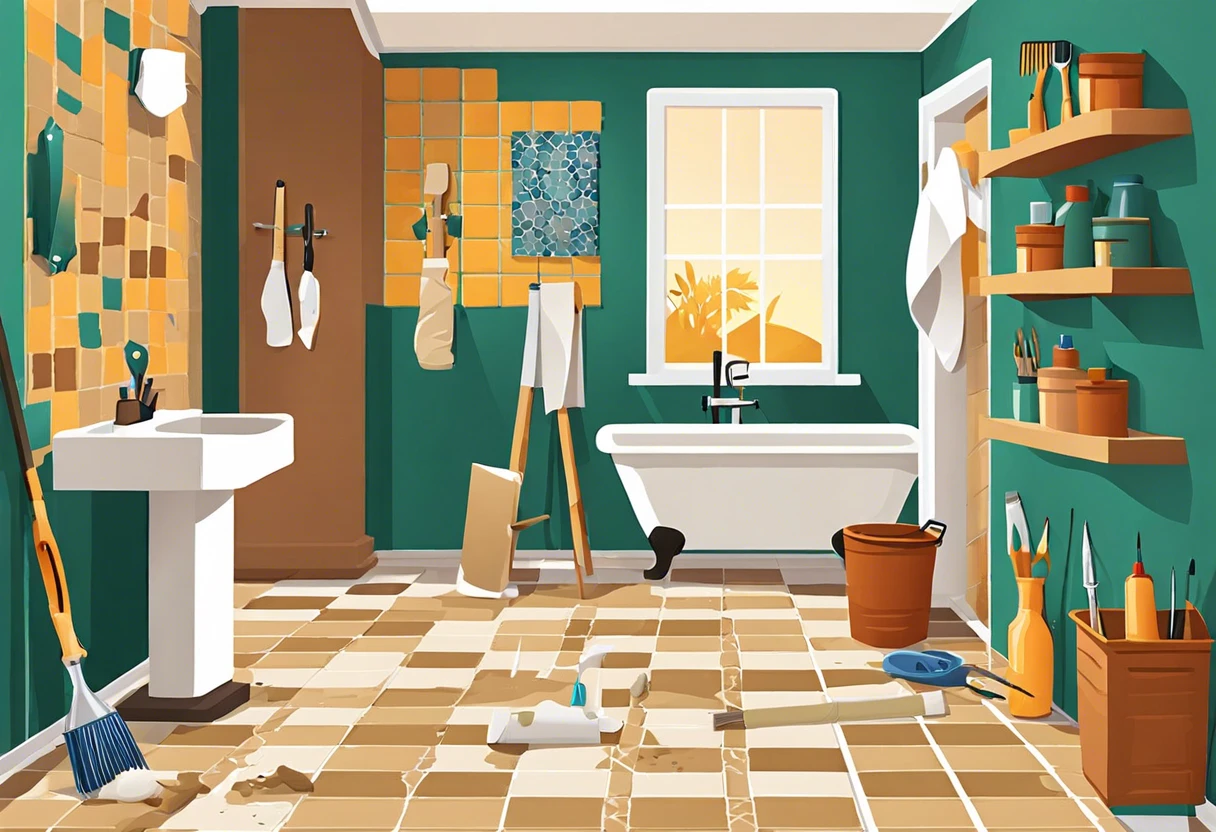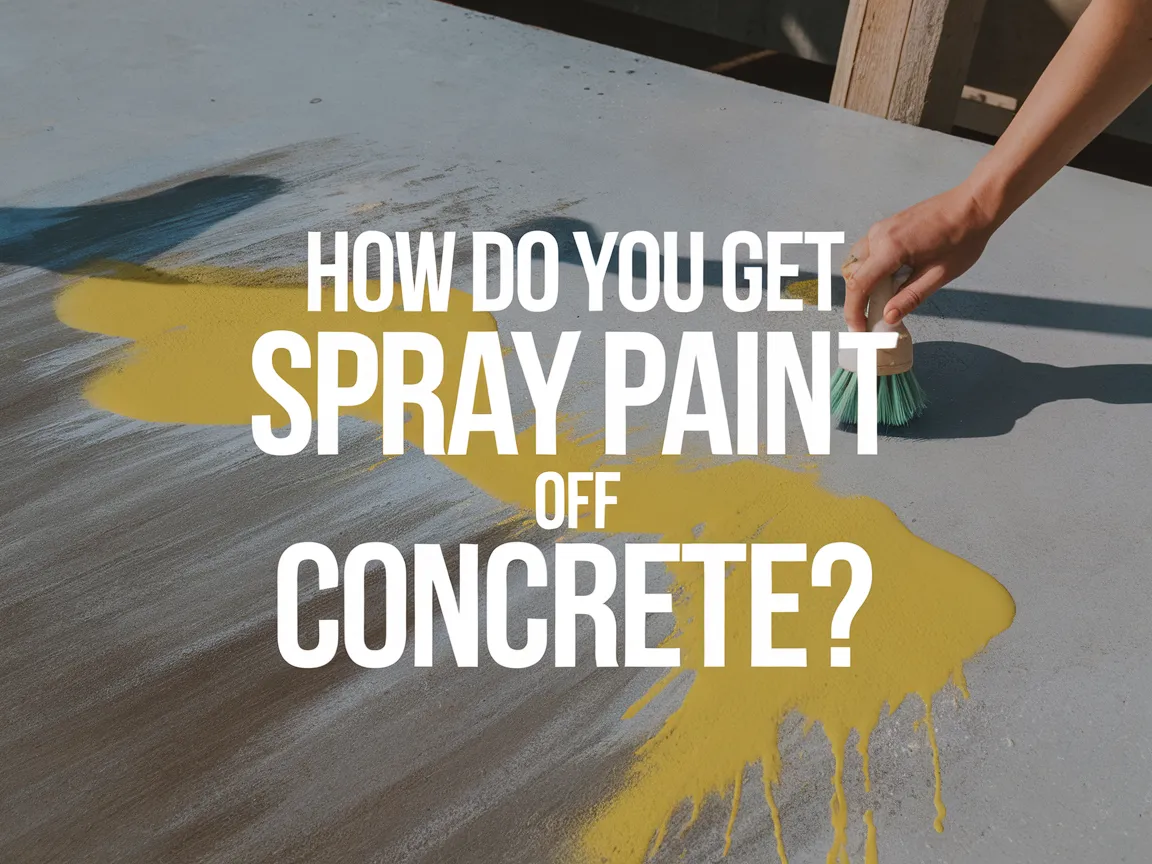Can You Tile Over Painted Drywall?
Published on: May 27, 2025 | Last Updated: January 7, 2025
Written By: Sarah McClintock
Drywall is a flat wall board made of gypsum and covered with paper. It’s like a soft shell for your room that helps create walls and ceilings.
So, can you tile over painted drywall? It’s crucial to know because the right prep can save you time and money. I remember a project where I skipped important steps and ended up redoing it, which taught me the hard way!
In this guide, we’ll discuss essential considerations before you tile installation techniques, a step-by-step process, choose the right colors, types of tiles you can use, factors that impact success, common issues, and DIY ideas to inspire you. Plus, we’ll touch on exciting related topics like how to prep drywall for painting and whether you can paint over sheetrock.
Contents
- 1 Can You Tile Over Painted Drywall?
- 2 What is Drywall?
- 3 Essential Considerations Before You Begin Tiling
- 4 Choosing the Right Primer Before Tiling
- 5 Understanding Tile Adhesion on Painted Drywall
- 6 Tips for Testing Paint Adhesion
- 7 Step-by-step Process for Tiling Over Painted Drywall
- 8 Types Of Tiles Suitable for Use Over Painted Drywall
- 9 Factors Affecting the Success Of Tiling Over Painted Drywall
- 10 Impact of Moisture on Tiling Over Painted Drywall
- 11 Best Practices for Preparing Painted Drywall for Tile
- 12 Long-term Care for Tiled Surfaces on Painted Drywall
- 13 Common Issues Encountered When Tiling Over Painted Drywall
- 14 Finishing Touches for Your Tiled Surface
- 15 Frequently Asked Questions
- 16 Conclusion: Final Thoughts on Tiling Over Painted Drywall
- 17 Useful Resources
Can You Tile Over Painted Drywall?
You can tile over painted drywall, but prep work is key. First, make sure the paint is clean and in good condition. If it’s glossy, rough it up with sandpaper or use primer. This ensures your tiles adhere well. When working with different surfaces, you might wonder about painting techniques for various materials.
The Finishing Touch
A freshly painted wall is a blank canvas. The best way to bring your room to life is with a single piece of statement art that ties everything together.
Browse Wall Art at Big Wall DecorWhat is Drywall?
Drywall, or gypsum board, is a construction material made from gypsum plaster sandwiched between two sheets of heavy paper. It typically comes in 1/2 inch (12.7 Mm) and 5/8 inch (15.9 Mm) thicknesses and measures 4 feet by 8 feet (1.2 M by 2.4 M), though larger sheets are available.
You might wonder about tiling over painted drywall. I’ve faced this situation during a home renovation, raising some important questions about the prep work you’ll need to consider.
I once used drywall for a kitchen project that required a smooth surface before tiling. I found that prepping drywall for painting can directly affect tile adhesion, especially when the surface is painted. If you’re considering a similar project, it’s crucial to ensure you have the best base by addressing how to clean up drywall dust before painting.
Essential Considerations Before You Begin Tiling
What do you need to get started?
- Tile Adhesive: You’ll need a product like thin-set mortar, specifically Mapei Thin-Set (1 Bag Covers About 80 Ft² or 7.4 M²). It’s crucial for attaching tiles securely to the painted drywall.
- Tile Spacers: Use 1/8-inch spacers, such as QEP 1/8” tile spacers. They keep your tile gaps even, which is key for a professional finish.
- Grout: Choose sanded grout like Polyblend, using a minimum of 10 oz (0.3 L) per 65 ft² (6 M²) area. It fills joints tightly to prevent water damage.
- Surface Cleaner: Opt for a degreaser like Krud Kutter; it’s essential for prepping your drywall, ensuring better adhesive adhesion.
That covers key factors to consider before starting tiling. Let’s now take a look at selecting the appropriate primer for tiling.
Also See: Can You Paint Galvanized Metal? Tips for Success!

Choosing the Right Primer Before Tiling
Using the right primer can enhance tile adhesion. Let’s break down your options.
The Finishing Touch
A freshly painted wall is a blank canvas. The best way to bring your room to life is with a single piece of statement art that ties everything together.
Browse Wall Art at Big Wall Decor| Primer Type | Best For | Application Method | Coverage (Approx.) |
|---|---|---|---|
| Bonding Primer | Glossy Painted Surfaces | Brush or Roller | 250-400 ft² (23-37 m²) per gallon |
| Oil-Based Primer | High Moisture Areas | Brush or Spray | 200-350 ft² (19-32 m²) per gallon |
| Water-Based Primer | Lightly Textured Surfaces | Roller | 300-450 ft² (28-42 m²) per gallon |
| Shellac Primer | Covering Stains | Brush | 200-300 ft² (19-28 m²) per gallon |
That covers selecting the proper primer for your tiling project. Let’s now take a look at tile adhesion on painted drywall.
Understanding Tile Adhesion on Painted Drywall
Tile adhesion depends on various factors. Let’s look at what makes a good bond.
- Surface Porosity: More porous surfaces bond better. Paint reduces porosity, which is why prep is key.
- Temperature: Apply tile when temperatures are stable. Ideal ranges are between 50°F to 90°F (10°C to 32°C).
- Humidity Levels: Too much humidity can affect adhesive curing time. Aim for 40-60% indoor humidity for best results.
That covers the basics of tile adhesion on painted drywall. Let’s now take a look at methods for testing paint adhesion.
Tips for Testing Paint Adhesion
Testing paint adhesion can save you headaches. Here’s a quick method:
- Use a piece of clear tape, about 3 inches wide.
- Press it firmly onto the painted surface.
- Quickly pull it off. If paint peels away with it, you’ll need to address the surface before tiling.
That covers tips for assessing paint adhesion. Let’s now take a look at the step-by-step procedure for tiling over painted drywall.

Step-by-step Process for Tiling Over Painted Drywall
Here are the steps for successfully applying tile over painted drywall. Don’t skip any step for the best results!
-
Assess the Condition Of the Painted Drywall
Your first task is to inspect the drywall for peeling paint or damage. Fix or patch any areas that need attention; fill cracks with joint compound and secure any loose spots for optimal adhesion.
It’s also crucial to check if the paint is glossy. If it is, lightly sand it to help the tile adhesive grip better. A solid surface makes a significant difference!
-
Prepare the Surface for Tiling
Clean the drywall thoroughly to remove dust, grease, or residue. A damp cloth with mild detergent should work well. Ensure the surface is completely dry before proceeding.
Consider applying a primer designed for drywall if you see signs of texture or uneven paint. This step seals the surface better, giving your adhesive a stronger grip.
-
Select the Right Adhesive for the Job
Choose a thin-set mortar or tile adhesive specifically for drywall applications. A mortar rated for both wall and floor tiles usually works well for most projects.
I recommend using a polymer-modified thin-set for added strength. It often provides better flexibility and binds more effectively to painted surfaces. If you’re considering painting your bathroom sink before tiling, preparing the surface correctly matters. Trust me, the right adhesive can make the difference between tiles falling off or staying put!
-
Start Tiling in a Strategic Pattern
Begin at the center of the wall and work your way outward. Use a level to ensure your first tile is straight, as it sets the tone for the rest.
Keep a consistent grout line. Spacers help maintain uniform gaps between tiles, creating an attractive finish and making grouting easier later on. They usually come in 1/16 inches (1.59 Mm) or 1/8 inches (3.18 Mm), depending on tile size.
-
Allow for Drying and Curing Times
Once all tiles are laid, let them cure according to your adhesive’s instructions, usually around 24 hours. Avoid disturbing the installation during this time for the best results.
After the initial setting, perform any necessary grouting, ensuring you press well into the joints. Each layer of adhesive, grout, and tile needs proper time to bond, so patience ensures long-lasting success.
Types Of Tiles Suitable for Use Over Painted Drywall
Let’s explore different types of tiles: ceramic, porcelain, glass, and vinyl.
-
Ceramic Tiles
Ceramic tiles are durable and water-resistant, suitable for various environments. Standard sizes include 12×12 inches (30×30 Cm) and 18×18 inches (45×45 Cm). You can lay these on painted drywall, but be sure to prep the surface well. If your paint seems too thick for proper application, you might want to adjust paint consistency before tiling.
-
Porcelain Tiles
Porcelain is denser than ceramic, making it ideal for high-traffic areas. They typically come in sizes like 12×24 inches (30×61 Cm). If you choose porcelain, make sure the drywall is clean and dust-free; otherwise, the adhesive may not adhere properly.
-
Glass Tiles
Glass tiles offer a unique touch with their glossy finish, available in sizes like 1×1 inches (2.5×2.5 Cm). While they’re visually appealing, you’ll need specialized adhesive to install them over painted drywall.
-
Vinyl Tiles
Vinyl tiles are flexible and easy to install. They come in sizes such as 12×12 inches (30×30 Cm) and can often be laid directly on painted drywall without special primer. They’re a great choice for DIYers, especially in low-traffic areas. When working on home improvement projects, you might want to know how temperature affects painting conditions.
I often think ceramic tiles are the best option for kitchen backsplashes. They resist moisture and are easy to clean!
Factors Affecting the Success Of Tiling Over Painted Drywall
What factors affect tiling over painted drywall? Here’s a quick rundown.
-
Paint Type: Glossy or textured paint can cause adhesion issues, so use a suitable primer.
-
Surface Preparation: Cleaning and sanding the drywall helps tiles stick better, ensuring durability.
-
Drywall Condition: Repair any cracks or damage first to avoid future complications.
-
Tile Weight: Heavier tiles may need extra support; ensuring stability is key for longevity.
Impact of Moisture on Tiling Over Painted Drywall
Moisture can make or break your tiling project. Understanding how it affects your walls is essential.
- High Humidity: Excess humidity can weaken adhesives and cause tiles to lift. Aim for humidity levels between 40% and 60% during installation.
- Water Exposure: Areas like bathrooms or kitchens are prone to moisture. Always use waterproof adhesive for these environments.
- Signs of Moisture Damage: Look for peeling paint, mold, or dark spots. Address these issues before tiling to ensure a solid foundation.
Best Practices for Preparing Painted Drywall for Tile
Preparing your painted drywall properly can ensure lasting adhesion. Here are some best practices.
The Finishing Touch
A freshly painted wall is a blank canvas. The best way to bring your room to life is with a single piece of statement art that ties everything together.
Browse Wall Art at Big Wall Decor| Preparation Step | Purpose | Recommended Tools |
|---|---|---|
| Clean the Surface | Removes dirt and grease for better adhesion | Sponge, mild detergent |
| Sand the Surface | Scuffs gloss finish for improved bonding | Sandpaper (120-grit) |
| Apply Primer | Enhances bonding and creates a strong surface | Primer suitable for painted surfaces |
Long-term Care for Tiled Surfaces on Painted Drywall
Maintaining your tiled drywall keeps everything looking great over time. Here are some key tips.
- Regular Cleaning: Use a damp cloth to wipe off dirt or dust. Avoid harsh chemicals that can damage grout.
- Inspect Grout: Check for cracks or gaps quarterly. Repair these immediately to prevent water intrusion.
- Moisture Management: Use exhaust fans in bathrooms or kitchens to reduce humidity levels. This minimizes moisture buildup, prolonging tile life.
Common Issues Encountered When Tiling Over Painted Drywall
When my friend tiled over painted drywall, the tiles didn’t adhere well. She didn’t sand the glossy paint, which caused slipping. Roughening the surface with 120-grit sandpaper (0.30 Mm) before tiling can prevent this issue.
Use a suitable thin-set mortar (Adhesive) rated for painted surfaces. Ensure the drywall is clean—removing dust allows for better bonding and a solid finish.
Finishing Touches for Your Tiled Surface
After you’ve tiled over your painted drywall, seal the grout with a high-quality silicone sealant, like Permatex Clear Silicone. Follow the drying time of 24 hours for the best results.
Inspect grouted lines weekly for cracks or shallow spots. Use a bright LED flashlight to spot gaps and uneven layers to ensure your tiles are secure and long-lasting.
An insider tip: For a polished finish, use a specialized grout sealer, like Aqua Mix Grout Sealer. This adds an extra layer of protection against moisture.
For professionals, apply thin-set mortar at a 3 mm (1/8 Inch) thickness for better adhesion on painted surfaces. Always dampen the drywall before applying to ensure maximum bond strength.
Also See: Can You Paint Styrofoam? Tips for a Great Finish!
Frequently Asked Questions
What Should I Do if My Tile is Not Adhering to Painted Drywall?
If your tile isn’t adhering to painted drywall, you need to fix the surface first. This happens because the paint creates a barrier, preventing proper adhesion. You might sand the area lightly or use a special primer designed for tile. This ensures tiles stick securely, reducing potential peeling.
Is It Necessary to Remove the Paint Before Tiling?
No, it isn’t necessary to remove paint before tiling, but it helps. Proper adhesion improves with smooth surfaces. If the paint is glossy or damaged, using a bonding primer can assist tiles in sticking better. This can even save you time and hassle in the long run. When preparing your surface, you might want to clean your painting tools thoroughly to ensure a pristine workspace.
Can I Use Any Type Of Adhesive for Tiling Over Painted Drywall?
No, you can’t use just any adhesive for tiling over painted drywall. Use thin-set mortar specially designed for painted surfaces, ensuring your tiles stay put. Many adhesives don’t stick well to painted surfaces and can fail over time, leading to costly repairs. Before applying tiles, you’ll want to properly prepare the surface with thorough cleaning.
How Can I Tell if My Drywall is Moisture-damaged?
You can tell if your drywall is moisture-damaged by looking for stains or soft spots. Generally, if the drywall feels mushy or there’s visible mold, act fast! Restoring moisture-damaged areas early prevents structural problems and extensive repairs. Don’t ignore those signs!
What is the Best Grout for Tiles Installed Over Painted Drywall?
The best grout for tiles over painted drywall is flexible or polymer-modified grout. This type helps accommodate slight shifts in the tile without cracking. Proper grout ensures tight seals, resisting moisture and mold. Consider using sanded grout for larger tile joints for better bonding. When working with painted surfaces, it’s crucial to understand potential risks and safety precautions for burning painted wood materials.
Can You Use Drywall Primer on Painted Walls?
Yes, you can use drywall primer on painted walls to improve adhesion for new paint or tile. Applying primer helps create a tacky surface for better sticking. Make sure to select a primer suitable for the existing paint to avoid complications later on. If you’re curious about alternative painting techniques, chalk paint offers unique surface options.
How to Prep Drywall for Painting?
To prep drywall for painting, start with cleaning dust and debris. Then, patch holes or blemishes first with spackle or compound. Lastly, lightly sand the primed surface prior to painting. Proper prep results in smoother finish and better paint adhesion.
Conclusion: Final Thoughts on Tiling Over Painted Drywall
We’ve reached the end, and I hope you found this information useful. We discussed what drywall is, essential considerations for tiling, a step-by-step guide, suitable tile options, key success factors, common challenges, finishing touches, and DIY project ideas.
So, can you tile over painted drywall? The answer is yes, but be sure to properly prepare your surface by using the right primers or adhesives and ensuring that the paint is intact. If you need further assistance with your project, feel free to reach out.
For more insights and tips, check out Paint Answers for a comprehensive resource on painting and home improvement.
Useful Resources
- Smith, R. (2003). The Artist’s Handbook of Materials and Techniques (5th ed.). New York, NY: Knopf.
- Tile on painted drywall | DIY Home Improvement Forum
- How to Tile Over Painted Drywall
- Installing backsplash tile over freshly painted drywall | Contractor Talk – Professional Construction and Remodeling Forum









